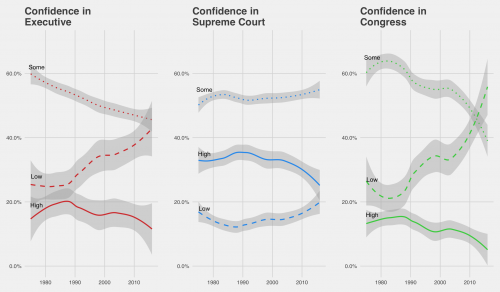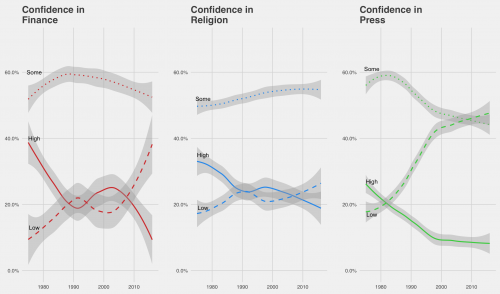Social institutions are powerful on their own, but they still need buy-in to work. When people don’t feel like they can trust institutions, they are more likely to find ways to opt out of participating in them. Low voting rates, religious disaffiliation, and other kinds of civic disengagement make it harder for people to have a voice in the organizations that influence their lives.
And, wow, have we seen some good reasons not to trust institutions over the past few decades. The latest political news only tops a list running from Watergate to Whitewater, Bush v. Gore, the 2008 financial crisis, clergy abuse scandals, and more.
Using data from the General Social Survey, we can track how confidence in these institutions has changed over time. For example, recent controversy over the Kavanaugh confirmation is a blow to the Supreme Court’s image, but strong confidence in the Supreme Court has been on the decline since 2000. Now, attitudes about the Court are starting to look similar to the way Americans see the other branches of government.

Source: General Social Survey Cumulative File
LOESS-Smoothed trend lines follow weighted proportion estimates for each response option.
Over time, you can see trust in the executive and legislative branches drop as the proportion of respondents who say they have a great deal of confidence in each declines. The Supreme Court has enjoyed higher confidence than the other two branches, but even this has started to look more uncertain.
For context, we can also compare these trends to other social institutions like the market, the media, and organized religion. Confidence in these groups has been changing as well.

Source: General Social Survey Cumulative File
It is interesting to watch the high and low trend lines switch over time, but we should also pay attention to who sits on the fence by choosing some confidence on these items. More people are taking a side on the press, for example, but the middle is holding steady for organized religion and the Supreme Court.
These charts raise an important question about the nature of social change: are the people who lose trust in institutions moderate supporters who are driven away by extreme changes, or “true believers” who feel betrayed by scandals? When political parties argue about capturing the middle or motivating the base, or the church worries about recruiting new members, these kinds of trends are central to the conversation.
Inspired by demographic facts you should know cold, “What’s Trending?” is a post series at Sociological Images featuring quick looks at what’s up, what’s down, and what sociologists have to say about it.
Evan Stewart is an assistant professor of sociology at University of Massachusetts Boston. You can follow his work at his website, on Twitter, or on BlueSky.
Comments 8
Bob — July 5, 2019
Now is the winter of our discontent
Made glorious summer by this sun of York;
And all the clouds that lour'd upon our house
In the deep bosom of the ocean buried.
Now are our brows bound with victorious wreaths;
Our bruised arms hung up for monuments;
Our stern alarums changed to merry meetings,
Our dreadful marches to delightful measures.
Grim-visaged war hath smooth'd his wrinkled front;
And now, instead of mounting barded steeds
To fright the souls of fearful adversaries,
He capers nimbly in a lady's chamber
To the lascivious pleasing of a lute.
But I, that am not shaped for sportive tricks,
Nor made to court an amorous looking-glass;
I, that am rudely stamped and want love's majesty
To strut before a wanton ambling nymph;
Kele Joen — April 12, 2021
I have been part of some Social institutions where I enjoyed my time very well with some amazing persons who helped me to run my life towards success. Everyone should at least some a few years in these institutions. I read website review that provides online writers for assistance in the writing work.
Jason Adams — May 24, 2022
Thanks for article. It is now fashionable and popular to take care of your security. Learn more about how to detect spyware on your devices: https://celltrackingapps.com/how-to-detect-spyware/
David Willy — April 11, 2023
Creative agencies also offer a range of services that are designed to help businesses achieve their marketing and branding goals. For example, they can develop a brand identity that accurately reflects a business's values and mission. Another advantage of working with a Creative Agency is the ability to save time and resources.
Laura Partin — June 1, 2023
The backrooms is comprised of a number of stages, each of which represents an additional, more intricate layer of the backrooms. Each level features its own distinct aesthetic, arrangement, and dangers. On some levels, there are elevators or portals that will carry you to the next level in the game. is comprised of a number of stages, each of which represents an additional, more intricate layer of the backrooms. Each level features its own distinct aesthetic, arrangement, and dangers. On some levels, there are elevators or portals that will carry you to the next level in the game.
Riteway Towing — December 6, 2023
tow truck Queens ny are the heroes on the bustling streets of NYC. They have the capacity to handle cars to heavy vehicles safely, without any scratch. These trucks are designed to handle various towing needs.
Audia — February 19, 2024
I think this article gives a good overview on the structure of the social demographics so many things affect the mental process and the emotions on this topic it definitely capitalizes on it
Cameron Tilly — February 20, 2024
I love this article. I totally agree with how buy-ins for institutions are crucial for their success and the overall production of everything involved. Trust in institutions are crucial for everything, such as voting and other things. The graphics on trust in government and certain branches really shows how success of an institution really relies on the people that back it, and not the people that make the decisions.